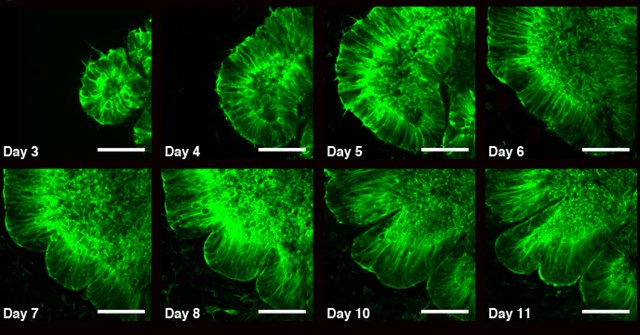
11 days of brain research at the Weizmann Institute of Science, Israel.
Israeli researchers have managed to grow tiny model brains in the lab to discover how the brain’s convolutions are created.
A normal brain is as wrinkly as a walnut. And in cases where a person is born with a smooth brain, devoid of folds, he faces severe developmental difficulties.
It has long been known that these folds and wrinkles are meant to enable the brain to be compressed into the space of a skull, and that they develop in embryo. But the question of how they develop, biologically and physically, has preoccupied brain researchers for years, as has the no less important question of what causes problems to arise in this process.
Now, scientists from the Weizmann Institute of Science in Rehovot, working with tiny model brains that they grew in the lab through an innovative process, have discovered how these folds are created. They also discovered a group of genes involved in disrupting the normal development of these folds, which conceal some of the brain’s most important functions. The study was published Monday in the journal Nature Physics.
The study was conducted by Eyal Karzbrun, a researcher in Prof. Orly Reiner’s molecular genetics lab.
Back in 1993, Reiner discovered a mutation in a gene called LIS1 that causes babies to be born with a smooth brain, and therefore with severe brain damage. This gene normally plays a major role in creating the cytoskeleton of brain cells.
“Children born with a smooth brain suffer from very severe deficiency in their brain function, which leads to a series of diseases and short life expectancy,” Reiner said. “But despite all the studies that have been conducted, it still isn’t clear how and why these brains without folds are created.”
The first significant development occurred in the last decade, when a team of researchers from Japan and Austria for the first time managed to grow structures called organoids, which resemble a human brain, from fetal stem cells.
“We hoped this would enable us to understand the developmental processes of the human brain, which can’t be understood through model animals like mice because in them, the brain’s normal structure is smooth,” Reiner said. But it quickly became clear that the method had several flaws and didn’t approximate the development of a real brain closely enough.
To overcome these problems, Karzbrun, a physicist by training, developed a new method of growing organoids. This method allows the cells to organize themselves into a thin, rounded shape surrounding a narrow space; the resulting structure is reminiscent of a pita. This thin tissue allowed real-time simulation of the brain’s development.
The first convolutions appeared during the organoids’ second week of development and gradually deepened. This is the first time folds have ever been detected in organoids.
Physically, the folds are created by a dynamic between two opposing forces. One force is contraction of the cytoskeleton in the organoid’s core. The other is expansion of the cell nucleus at the organoid’s perimeter.
At this stage, the LIS1 gene which Reiner discovered 25 years ago entered the picture. The new model allowed the researchers to study the differences between normal brain cells and those which carried a mutation of the gene.
“We discovered a very significant difference in the physical and biological characteristics of the cells — for instance, in the speed at which cell nuclei move to the core and in the proteins found in the tissue between the cells,” Reiner said.
Even before the research was published, the scientific community showed interest in the new method of growing organoids. “We have a model here that isn’t precisely a brain, but it’s a good model of the brain’s development, and now we understand better why sick people have brains that are smooth rather than folded,” Reiner said.
The researchers plan to continue developing the model in an effort to understand additional diseases that affect brain development, including microcephaly (an abnormally small brain), epilepsy and schizophrenia.
Jacob Hanna, an expert on fetal stem cells, and doctoral student Aditya Kshirsagar were also involved in the study.
